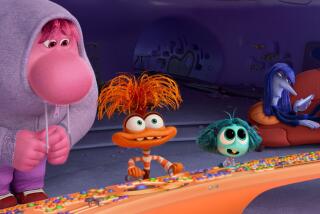As the reboot of ‘Twin Peaks’ unfolds, a reminder: It’s meant to be experienced, not necessarily understood
Nearly halfway through the 18-episode, late-arriving third season of “Twin Peaks,” we can see some of what director David Lynch (and co-writer, with series co-creator Mark Frost) is up to, if not where he’s going with the latest and reportedly last installment of his mutli-planar, domestic-comic, cosmological horror-story murder mystery. We can see what sort of television he is making, and it is not quite like any other television you can name, including the old “Twin Peaks.”
That original series, which aired in 1990 and 1991, was made for a broadcast network, paced for commercial breaks and weekly cliffhangers. Its models were dynastic prime-time soap operas — the “Twin Peaks” tag line “Who Killed Laura Palmer?” was an echo of the “Who Shot J.R.?” campaign run by “Dallas” a decade earlier — and the big-screen exploitation films and glossy romances that would have been part of Lynch’s own moviegoing youth.
It was “cinematic” in a way that was rare for TV at the time but which is now standard. Photographed by Peter Deming, who also shot Lynch’s “Mulholland Drive,” the new series has a dry, sharp-edged crispness; interestingly, much of it looks like “television.” Except when focus is used to direct attention, the depth of field is deep (where now it is fashionably shallow), the lighting flat, the image-sharped edged and full of information. The camera stays still for the most part, dollying in a bit now and again, panning with robotic precision to take in a vista. In some way that feels consistent with Lynch’s body of work, this kicking back against sophistication, this plainness in the service of the strange. It’s prose used to make poetry.
There is a story being told, of course, even if it is a story that is sometimes difficult to work out and harder to summarize. It’s not that it’s complicated, particularly, when you break it down; but not everything is obvious at first, and full (or at any rate, fuller) comprehension requires remembering things from earlier episodes, the original series and “Fire Walk With Me,” the prequel film that followed the series. That the current series takes place in multiple locations, adding many new characters and threads, makes it even harder to track.
This can be accounted a failure, on an ordinary scale of serial television craft. But, as might be said of Lynch’s work generally, “Twin Peaks” is designed to be re-watched; initial disorientation is part of the game. The strangeness of what’s being offered at times, not only in the scenes set in supernatural other worlds, out in space, or in the middle of dark oceans, but in ordinary diners and bedrooms and offices, puts you in the moment. The series is meant less to be understood than experienced, to be felt in the moment and sorted out later, to whatever extent the viewers feels that sorting is necessary.
(It is acceptable, I think, to remain confused. There’s no reason the Lynch-ian universe should be any less mysterious than the one we seem to live in, with its dark matter, spooky entanglements, hypothetical multiverses and 10-dimensional string theory. One mystery leads to another; one door leads into a room where another door leads out. And not just metaphorically — it’s a “Twin Peaks” trope.)
Although it has its explosive passages, “Twin Peaks,” like Lynch films in general, is informed by a kind of radical stillness. It is not the slowness of many modern television dramas, which take advantage of an eight- or 10- or 12-hour story arc to take their time in telling a story, but something more dreamlike, ritual and formal, akin to Robert Wilson’s “Einstein on the Beach” or Kabuki theater.
If a character walks down a corridor, you will see him or her walk most or all of that corridor. If five shovels need to be spray painted gold, as they are in a scene from the current season, you will see them painted gold, one by one. One lengthy shot involves nothing but a man sweeping a roadhouse floor as Booker T. and the MG’s “Green Onions” plays in the background, all the way through. This stretches time, as do long silences between and inside conversations.
In “Twin Peaks” as elsewhere, his special effects are mostly old-fashioned. Running the film backward, overexposing the film, shaking the camera, flashing the lights, superimposing images. Some of this may be accomplished digitally now, but the effect is almost always of something old-fashioned, backward-looking.
They have more to do with the work of Georges Méliès, famous for his 1902, Jules Verne-inspired “A Trip to the Moon,” or with Surrealist filmmakers like Luis Bunuel and or Jean Cocteau than with the gigabyte-crunching, computer-generated effects of a James Cameron or Michael Bay movie. Regard Lynch’s big-budget sci-fi flick, “Dune,” released in 1984, after all three original “Star Wars” films — George Lucas reportedly offered Lynch the director’s chair on “Return of the Jedi” — “Close Encounters of the Third Kind,” “Blade Runner” and “Alien.” Its effects are obviously hand-painted, hand-sculptured, hand-layered, hand-operated.The effects look special because the seams show, not in spite of it. They’re like magic tricks that are no less magic for explaining the illusion.
There is something of the 20th century student filmmaker inside the 21st century old master; it keeps his work fresh and young. It isn’t conventional, or even “right.” Scenes run long; some shots are snatched away before we can tell what we’re seeing. The camera might be placed at what feels like slightly the wrong, less-than-professional angle. But it makes the viewer unusually alive to the action. There is a kind of intentional inelegance, a stubborn awkwardness to Lynch’s work, something akin to outsider art, that keeps it from ever seeming glib,soulless or less than felt.
Art is, in one sense, a sort of failure — it’s what the artist can’t help doing, the things beyond control or craft, however sophisticated the technique. It’s the difference between style, which is hard-wired, and stylishness, which is the approximation of some other artist’s style. Lynch is that kind of failure — an artist, helplessly — and “Twin Peaks” is again one of the best things on TV.
‘Twin Peaks: The Return’
Where: Showtime
When: Episodes resume 9 p.m. Sunday, July 9
Rating: TV-MA-DL (may be unsuitable for children under the age of 17 with advisories for suggestive dialogue and coarse language)
Follow Robert Lloyd on Twitter @LATimesTVLloyd
ALSO
Splendid ‘Twin Peaks’ reboot is very much itself in its long-awaited return on Showtime
‘Twin Peaks’ and turning television into a genuine art form
Documentary ‘David Lynch: The Art Life’ is as elliptical as its subject
More to Read
The complete guide to home viewing
Get Screen Gab for everything about the TV shows and streaming movies everyone’s talking about.
You may occasionally receive promotional content from the Los Angeles Times.







